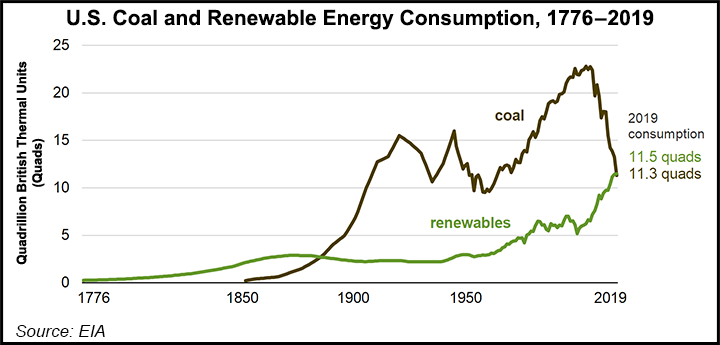NGI The Weekly Gas Market Report | E&P | NGI All News Access
U.S. Renewables Consumption Outpaced Coal in 2019, Thanks in Part to Natural Gas
The United States’ use of coal continued to decline in 2019, while renewable energy and natural gas consumption remained strong, according to the Energy Information Administration (EIA).

Last year was the first time, in fact, U.S. annual energy consumption from renewable sources exceeded coal consumption since at least 1885, EIA said Thursday.
“This outcome mainly reflects the continued decline in the amount of coal used for electricity generation over the past decade as well as growth in renewable energy, mostly from wind and solar. Compared with 2018, coal consumption in the United States decreased nearly 15%, and total renewable energy consumption grew by 1%,” EIA said.
“Coal-fired power generation has fallen below renewable energy for the first time in more than 130 years — when wood was the primary source of energy in the United States,” said Moody’s Benjamin Nelson, senior credit officer and lead coal analyst. “We expect ongoing secular decline in the demand for coal, accelerated by the economic fallout from the global outbreaks of Covid-19, will persist in the early 2020s.”
U.S. coal consumption decreased for the sixth consecutive year in 2019 to 11.3 quadrillion Btu, the lowest level since 1964, and electricity generation from coal fell to its lowest level in 42 years.
Meanwhile, EIA said, “Natural gas consumption in the electric power sector has significantly increased in recent years and has displaced much of the electricity generation from retired coal plants.”
The U.S. coal-fired generating fleet saw its output levels decline to nearly 966,000 GWh in 2019, the lowest level since 1976, marking the largest percentage decrease in history, according to EIA data.
The coal fleet’s rate of utilization also saw a significant decrease in 2019 to 48%, versus 67% capacity in 2010. While demand for electricity may have been the culprit for the decline, the EIA noted the increased output from natural gas-fired plants and wind turbines.
Total renewable energy consumption in the United States grew in 2019 for the fourth year in a row to a record-high 11.5 quadrillion Btu.
“Since 2015, the growth in U.S. renewable energy is almost entirely attributable to the use of wind and solar in the electric power sector. In 2019, electricity generation from wind surpassed hydro for the first time and is now the most-used source of renewable energy for electricity generation in the United States on an annual basis,” EIA said.
In the short-term at least, the economic impacts of Covid-19 may override such trends. Global natural gas demandis on track to drop by a record 5% in 2020 due to the economic impacts of the global pandemic, the International Energy Agency (IEA) said recently. The year/year decline, which follows 10 years of uninterrupted growth, would be the largest on record since natural gas demand developed at scale during the second half of the 20th century, the global energy watchdog said.
The power generation and industrial sectors are expected to account for 60% and 25% of the total decrease in gas demand, respectively, while the energy sector itself — including upstream operations, refining and pipeline gas compression — is seen accounting for 10% of the drop.
© 2024 Natural Gas Intelligence. All rights reserved.
ISSN © 1532-1231 | ISSN © 2577-9877 | ISSN © 1532-1266 |
